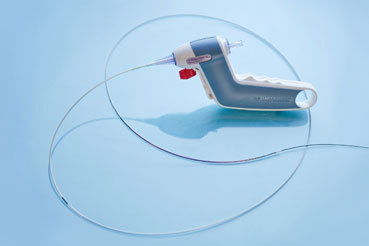
Biotronik has introduced its Pulsar stent technology in a 0.035”/6F platform and Passeo-14 balloon catheter, a dedicated 0.014” infrapopliteal percutaneous transluminal angioplasty (PTA) catheter, for lower limb treatment.
The Pulsar-35 features a triaxial delivery system designed to provide precise implantation accuracy, and the system benefits from the same stent design as the Pulsar-18—including features such as high multiaxis flexibility and optimised radial force specifically designed for the challenges of superficial femoral artery stenting. The stent is available in lengths from 30mm to 200mm and diameters of 5mm to 7mm.
Pulsar stent technology was proven effective during the 4EVER clinical study, with six-month clinical patency rates of 90%. Results were presented in January 2012 at The Leipzig Interventional Course (LINC), Germany, by principal investigator Marc Bosiers, chief of Surgery, AZ Sint Blasius, Dendermonde, Belgium.
The 4EVER study is a prospective, non-randomised, multicentre, 120-patient clinical investigation that evaluates the safety and efficacy of Pulsar stents in the superficial femoral artery (SFA). It examines both the acute and long-term performance of 4F-compatible devices. The primary endpoint is primary patency at 12 months, with secondary endpoints being technical success, time to haemostasis and wound complication rate.
Six-month highlights from 4EVER study data include: primary patency, 90%; freedom from target lesion revascularisation (TLR), 95.4%; technical success, 100%; and mean manual compression time, 8.12 minutes (no vascular closure devices used).
The promising 4EVER study data demonstrate the high technical success possible with 4F intervention and the encouraging clinical performance of Biotronik’s Pulsar stent systems. Full 12-month data from the 4EVER study will be announced at the CIRSE Annual Congress.
Passeo-14 balloon catheter
Biotronik has also introduced the Passeo-14 balloon catheter, a dedicated 0.014” infrapopliteal percutaneous transluminal angioplasty (PTA) catheter. Developed in collaboration with infrapopliteal experts, the device’s unique features are designed to address weaknesses common to infrapopliteal PTA catheters. Key features include a stiffened proximal catheter shaft and hydrophilic coating for excellent push transmission and crossability—plus a balloon-diameter-specific distal shaft length that provides optimised flexibility in tortuous pedal anatomy.
Available in balloon lengths of up to 220mm, this device may shorten procedure times and could reduce the need for multiple inflations.













